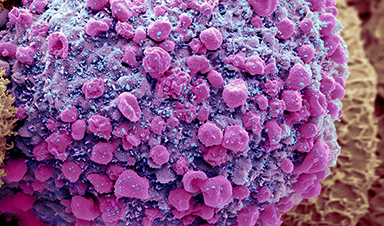Scientists are studying whether long COVID could be linked to viral fragments found in the body months after initial infection.
In the chaos of the first months of the coronavirus pandemic, oncologist and geneticist Ami Bhatt was intrigued by widespread reports of vomiting and diarrhoea in people infected with SARS-CoV-2. “At that time, this was thought to be a respiratory virus,” she says. Bhatt and her colleagues, curious about a possible link between the virus and the gastrointestinal symptoms, began to collect stool samples from people with COVID-19.
Thousands of miles away from Bhatt’s laboratory at Stanford Medicine in California, gastroenterology internist Timon Adolph was puzzled by accounts of gut symptoms in infected people. Adolph and his colleagues at the Medical University of Innsbruck in Austria started to assemble specimens, too — gastrointestinal-tissue biopsies.
Two years into the pandemic, the scientists’ foresight has paid off: both teams have recently published results1,2 suggesting that pieces of SARS-CoV-2 can linger in the gut for months after an initial infection. The findings add to a growing pool of evidence supporting the hypothesis that persistent bits of virus — coronavirus “ghosts”, Bhatt has called them — could contribute to the mysterious condition called long COVID.
Even so, Bhatt both urges scientists to keep an open mind and cautions that researchers have not yet nailed down a link between persistent viral fragments and long COVID. “Additional studies still need to be done — and they’re not easy,” she says.
Long COVID is often defined as symptoms that linger beyond 12 weeks after an acute infection. More than 200 symptoms have been associated with the disorder, which ranges in severity from mild to debilitating. Theories about its origins vary, and include harmful immune responses, tiny blood clots and lingering viral reservoirs in the body. Many researchers think that a mix of these factors contributes to the global burden of disease.
An early hint that the coronavirus might persist in the body came in work3 published in 2021 by gastroenterologist Saurabh Mehandru at the Icahn School of Medicine at Mount Sinai in New York City and his colleagues. By then, it was clear that cells lining the gut display the protein that the virus uses to enter cells. This allows SARS-CoV-2 to infect the gut.
Mehandru and his team found viral nucleic acids and proteins in gastrointestinal tissue collected from people who’d been diagnosed with COVID-19 an average of four months earlier. The researchers also studied participants’ memory B cells, which are pivotal players in the immune system. The team found that antibodies produced by these B cells were continuing to evolve, suggesting that, at six months after the initial infection, the cells were still responding to molecules made by SARS-CoV-2.
Inspired by this work, Bhatt and her colleagues found that a few people continued to shed viral RNA into their stool seven months after an initial mild or moderate SARS-CoV-2 infection, well after their respiratory symptoms had ended1.
Virus goes for the gut
Adolph says the 2021 paper inspired his team to look at their biopsy samples for signs of coronavirus. They found that 32 of 46 study participants who had had mild COVID-19 showed evidence of viral molecules in their gut seven months after acute infection. About two-thirds of those 32 people had long-COVID symptoms.
But all of the participants in this study had inflammatory bowel disease, an autoimmune disorder, and Adolph cautions that his data do not establish that there is active virus in these people, or that the viral material is causing long COVID.
In the meantime, more studies have suggested lingering viral reservoirs beyond the gut. Another team of researchers has studied tissue collected from autopsies of 44 people who had been diagnosed with COVID-19 and found evidence of viral RNA in many sites, including the heart, eyes and brain4. Viral RNA and proteins were detected up to 230 days after infection. The study has not yet been peer reviewed.
Viral hideouts
Nearly all of the people in that sample had had severe COVID-19, but a separate study of two people who had had mild COVID-19 followed by long COVID symptoms found viral RNA in the appendix and the breast5. Pathologist Joe Yeong at the Institute of Molecular and Cell Biology at the Agency for Science, Technology, and Research in Singapore, who is a co-author of the report, which has not been peer reviewed, speculates that the virus might infiltrate and hide out in immune cells called macrophages, which can be found in a variety of the body’s tissues.
All of these studies support the possibility that long-term viral reservoirs contribute to long COVID, but researchers will need to do more work to conclusively show a link, says Mehandru. They will need to document that the coronavirus is evolving in people who are not immunocompromised, and they will need to link such evolution to long COVID symptoms. “Right now there is anecdotal evidence, but there are a lot of unknowns,” Mehandru says
Bhatt is hopeful that samples will become available to test the viral-reservoir hypothesis. The US National Institute of Health, for example, is running a large study called RECOVER, which aims to tackle the causes of long COVID and will collect biopsies from the lower intestines of some participants.
But Sheng says he does not need to wait for a billion-dollar study to get more samples: an organization of people with long COVID has contacted him and offered to send samples from members who have had biopsies for various reasons, such as a cancer diagnosis, after their infections. “It’s really random, the tissue can come from everywhere,” he says. “But they don’t want to wait.”
News
New Once-a-Week Shot Promises Life-Changing Relief for Parkinson’s Patients
A once-a-week shot from Australian scientists could spare people with Parkinson’s the grind of taking pills several times a day. The tiny, biodegradable gel sits under the skin and releases steady doses of two [...]
Weekly injectable drug offers hope for Parkinson’s patients
A new weekly injectable drug could transform the lives of more than eight million people living with Parkinson's disease, potentially replacing the need for multiple daily tablets. Scientists from the University of South Australia [...]
Most Plastic in the Ocean Is Invisible—And Deadly
Nanoplastics—particles smaller than a human hair—can pass through cell walls and enter the food web. New research suggest 27 million metric tons of nanoplastics are spread across just the top layer of the North [...]
Repurposed drugs could calm the immune system’s response to nanomedicine
An international study led by researchers at the University of Colorado Anschutz Medical Campus has identified a promising strategy to enhance the safety of nanomedicines, advanced therapies often used in cancer and vaccine treatments, [...]
Nano-Enhanced Hydrogel Strategies for Cartilage Repair
A recent article in Engineering describes the development of a protein-based nanocomposite hydrogel designed to deliver two therapeutic agents—dexamethasone (Dex) and kartogenin (KGN)—to support cartilage repair. The hydrogel is engineered to modulate immune responses and promote [...]
New Cancer Drug Blocks Tumors Without Debilitating Side Effects
A new drug targets RAS-PI3Kα pathways without harmful side effects. It was developed using high-performance computing and AI. A new cancer drug candidate, developed through a collaboration between Lawrence Livermore National Laboratory (LLNL), BridgeBio Oncology [...]
Scientists Are Pretty Close to Replicating the First Thing That Ever Lived
For 400 million years, a leading hypothesis claims, Earth was an “RNA World,” meaning that life must’ve first replicated from RNA before the arrival of proteins and DNA. Unfortunately, scientists have failed to find [...]
Why ‘Peniaphobia’ Is Exploding Among Young People (And Why We Should Be Concerned)
An insidious illness is taking hold among a growing proportion of young people. Little known to the general public, peniaphobia—the fear of becoming poor—is gaining ground among teens and young adults. Discover the causes [...]
Team finds flawed data in recent study relevant to coronavirus antiviral development
The COVID pandemic illustrated how urgently we need antiviral medications capable of treating coronavirus infections. To aid this effort, researchers quickly homed in on part of SARS-CoV-2's molecular structure known as the NiRAN domain—an [...]
Drug-Coated Neural Implants Reduce Immune Rejection
Summary: A new study shows that coating neural prosthetic implants with the anti-inflammatory drug dexamethasone helps reduce the body’s immune response and scar tissue formation. This strategy enhances the long-term performance and stability of electrodes [...]
Scientists discover cancer-fighting bacteria that ‘soak up’ forever chemicals in the body
A family of healthy bacteria may help 'soak up' toxic forever chemicals in the body, warding off their cancerous effects. Forever chemicals, also known as PFAS (per- and polyfluoroalkyl substances), are toxic chemicals that [...]
Johns Hopkins Researchers Uncover a New Way To Kill Cancer Cells
A new study reveals that blocking ribosomal RNA production rewires cancer cell behavior and could help treat genetically unstable tumors. Researchers at the Johns Hopkins Kimmel Cancer Center and the Department of Radiation Oncology and Molecular [...]
AI matches doctors in mapping lung tumors for radiation therapy
In radiation therapy, precision can save lives. Oncologists must carefully map the size and location of a tumor before delivering high-dose radiation to destroy cancer cells while sparing healthy tissue. But this process, called [...]
Scientists Finally “See” Key Protein That Controls Inflammation
Researchers used advanced microscopy to uncover important protein structures. For the first time, two important protein structures in the human body are being visualized, thanks in part to cutting-edge technology at the University of [...]
AI tool detects 9 types of dementia from a single brain scan
Mayo Clinic researchers have developed a new artificial intelligence (AI) tool that helps clinicians identify brain activity patterns linked to nine types of dementia, including Alzheimer's disease, using a single, widely available scan—a transformative [...]
Is plastic packaging putting more than just food on your plate?
New research reveals that common food packaging and utensils can shed microscopic plastics into our food, prompting urgent calls for stricter testing and updated regulations to protect public health. Beyond microplastics: The analysis intentionally [...]























